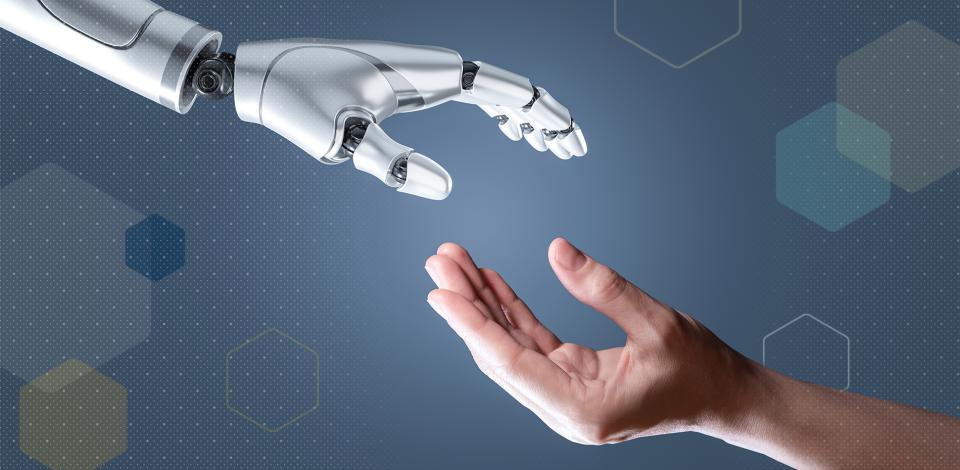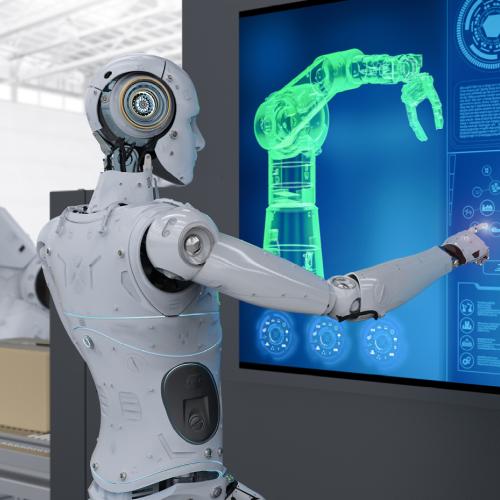Emerging Tech: The Role of Judgment in an AI Future
How humans and machines can work together in decision-making.

Artificial intelligence is growing more and more capable. It can master complex games of strategy – in 2016, Google’s AlphaGo AI program beat Go world champion Lee Sedol. It can recognize facial patterns better than humans – in a study that compared photos of real humans to photos of spoofed human faces, AI technology identified photos 143% more accurately and 10 times more quickly than human participants. And, AI can even convince us that it is a human, too – this year, ChatGPT passed the Turing test in a study conducted by OpenAI and Stanford University, fooling over half of the evaluators into believing they were interacting with a human rather than a machine.
As AI’s capabilities grow, so will its impact, affecting life on a larger scale in areas like government, society, and war. In a world increasingly interwoven with machines, how can we continue to thrive in the way we live and work?
DECISION MODELS: THE FOUNDATION OF ALL WORK
At the foundation of countless tasks is a decision model – a basic step process to carry out a certain action. In decision theory, the most basic model follows a specific flow: data, prediction, judgment, and action.
- Data - the assembling of comprehensive, relevant, accurate information.
- Prediction - breaking down this information to forecast potential outcomes and their consequences.
- Judgment - determining which set of outcomes and consequences reaps the most benefit.
- Action - carrying out the selected decision in real life.
WHERE AI EXCELS
As AI advances, it’s tempting to conclude that no jobs will be left for humans. However, when we look at the decision model, we find a different story.
Of the four stages in the model, AI can substitute mainly only for two – prediction and action.
We can create models that analyze data to predict the future. Think of the weather forecast, your GPS navigation system, and investments and finance strategy. We can also create machines that carry out actions for us. Take dishwashers, self-checkouts, and self-driving mining trucks. But for any singular field, you’ll be hard-pressed to find a job that can be performed by automation end-to-end.
McKinsey agrees. A recent study found that although about half of human tasks today can be automated, only 5% of jobs can be fully automated.
"AI, acting as a proficient data analyst, can tirelessly interpret vast amounts of data with impressive accuracy, making it indispensable in this big data-driven age," says Renita Folds, director of professional education at Georgia Tech Research Institute. "However, it's crucial to understand while AI may automate certain tasks, it's designed to support, not replace, human ingenuity, opening doors to new opportunities and greater productivity."
WHERE HUMANS EXCEL
The other two quadrants of the decision model – data and judgment – are unique to human capabilities, especially judgment.
“Judgment is fundamentally about deciding what matters,” explains Jon Lindsay, associate professor at the Georgia Tech School of Cybersecurity and Privacy and the Sam Nunn School of International Affairs.
Take this simple example: You’re deciding what to wear for the day ahead, so you look at the weather forecast. Thanks to the automation that analyzed various weather data (provided by humans, initially), you have a prediction of the chance, time, and heaviness of rain in your area. Now, you still have a judgment to make. For the prediction provided, is it worth wearing a rain jacket? You will have to consider several factors – How much do you mind carrying or wearing a rain jacket if it’s not raining? Would it be hot? Would it diminish your outfit? How much do you mind getting wet? How likely are you to be outside while it’s raining?
All these factors change depending on the day. When we extrapolate this kind of scenario to questions of war, government, and health, judgment becomes much more complicated – and impactful. The intricate depth of human understanding is necessary to uphold these judgment-based tasks across all fields.
Furthermore, as technological advancement makes data and predictions cheaper, faster, and more abundant, the value of judgment is growing – and so is the pressure.
“In economics, any time you reduce the price of a good, its complements become more valuable,” says Lindsay.
“Data and judgments are these complements, and as we automate more and more prediction tasks, the burden of judgment gets much higher.”
When we have more and more resources to leverage in decisions, the expectation for effective judgment increases.
However, human expertise is also vital in scenarios where data is low-quality, especially when corresponding judgment is not easy to define based on the predictions. These scenarios occur in areas such as strategy, command, and leadership, all of which require emotional and social intelligence, instincts that are unique only to humans.
For example, we have not seen AI create a successful company, lead a political movement, or set a legal precedent. These are human-only roles. "In the evolving job landscape, adaptability, continuous learning, and embracing the complementary role of AI will be the keys to professional growth and longevity," says Folds.
THE FUTURE OF AUTOMATION
Ultimately, AI will help us more than hinder us.
As AI makes prediction cheaper, better, and faster, it will produce more decisions to make, providing more opportunities for humans to focus on the strategic, meaningful work that goes into judgment tasks.
Studies continue to show that humans and machines work more efficiently together than apart. The University of Göttingen, for example, found that combined teams of humans and machines performed better in production logistics than machine-only and human-only teams, taking the least time to complete transport tasks. Additionally, since the creation of centaur chess (playing chess with both human intuition and machine intelligence), experts agree that human-computer teams are more effective in the game of chess than computers and humans alone.
“This is not about substitution,” Lindsay states. “When we consider the future of automation, we should think about how human beings and machines work together.” Instead of fearing the rise of AI, now is the time to learn how we can harness its power to enhance our current capabilities while also focusing our energy on growing our human skills.
Credits
Written by: Rachel Meyer
Editor & Digital Producer: Shannon Helton-Amos

